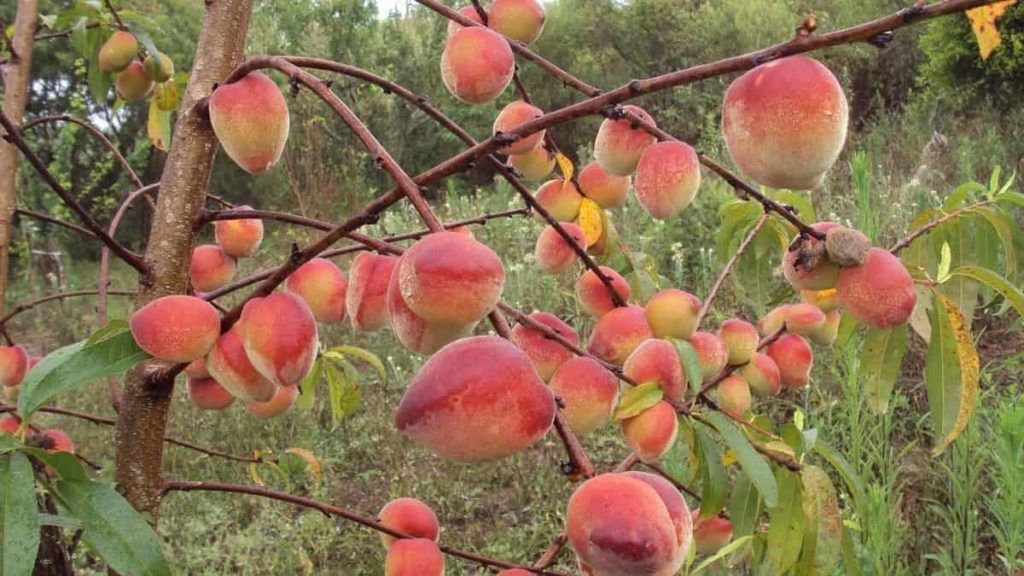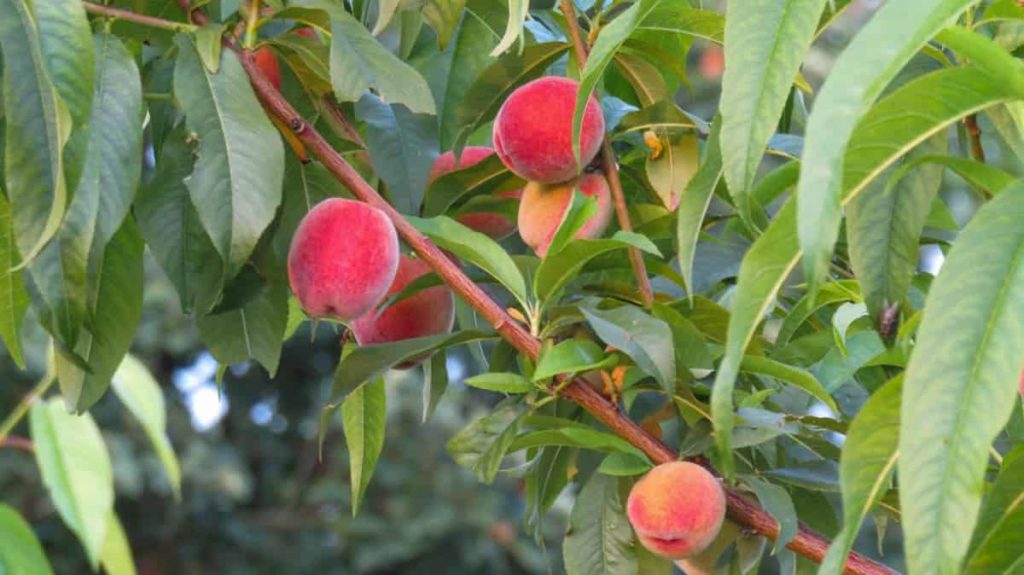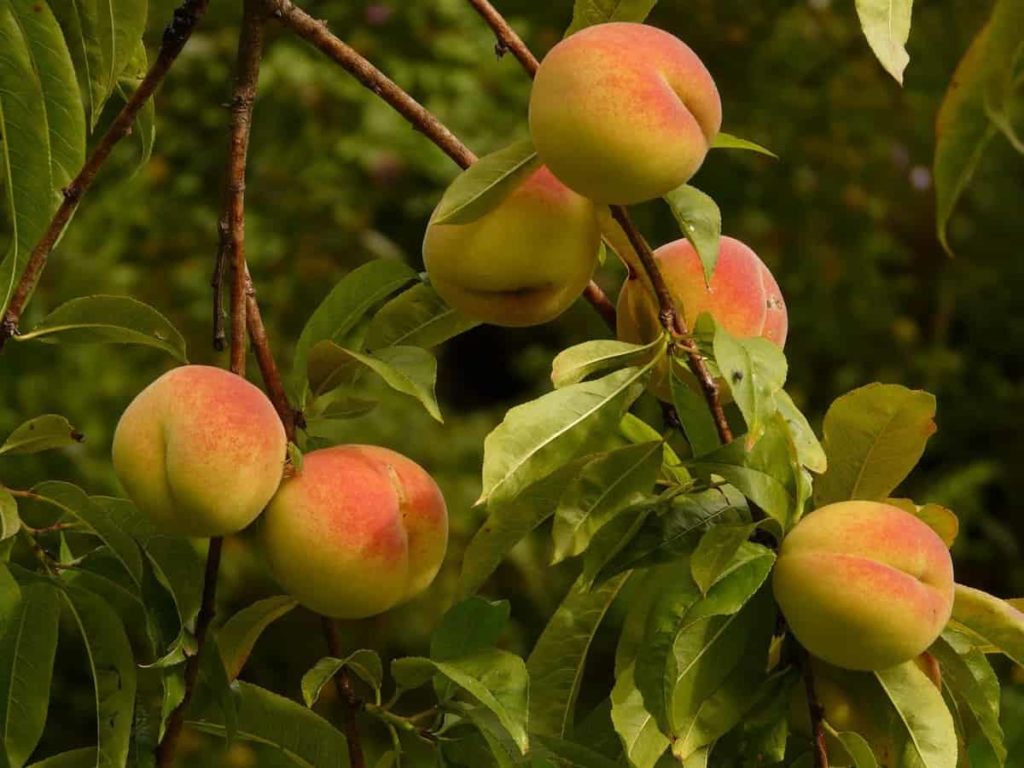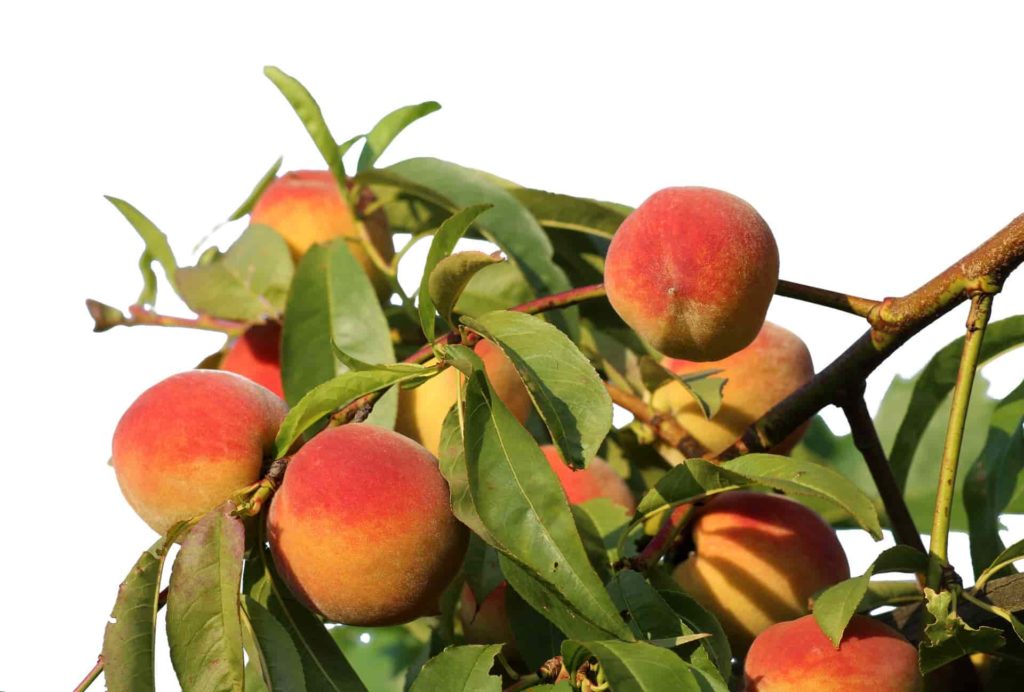Peach trees thrive best in well-drained soil. If soil tests indicate nutritious, fertile soil, you may not have to add any fertilizer until fruit production begins. Organic materials like compost and peat moss make it better to maintain soil fertility, drainage, and moisture. Organic material can also have an acidity effect. You can add 2.5 pounds of peat moss to one square yard of land, lowering the soil pH by one unit. You should measure soil pH after adding organic material to the soil. Let’s check out the best fertilizer for Peach trees.

The fertilizer of fruit trees balanced ensures a steady supply of all three nutrients, nitrogen, phosphorus, and potassium. Peach trees thrive in nitrogen-rich soil, and the essential nutrients they need include nitrogen, calcium, phosphorus, magnesium, sulfur, and potassium. These nutrients are already found in different soils, but soil testing will help determine the level and which nutrients are deficient. Low nutrients include chlorine, iron, manganese, boron, copper, zinc, and molybdenum.
A young Peach tree needs phosphorus as it encourages healthy, strong roots and flowers. The essential nutrients of Peach trees are magnesium, sulfur, and calcium. The lack of nutrients affects the shape of the leaves on a Peach tree. Both fruity and unaffordable Peach trees need the regular provision of nitrogen. It contributes to the size, production, and Peach tree vigor. The nitrogen requirement depends on the age of your fruit trees and the overall production of fruits. However, avoid adding too much nitrogen affecting fruit color and flower buds. Peach skin, taste, and color will be better if your soil has enough nitrogen.
Best fertilizer for Peach trees
Homemade fertilizers for Peach tree
- Epsom salt – Epsom salt is used to treat magnesium deficiency and help trees recover from the disease. Peach trees are rarely deficient in magnesium.
- Coffee grounds – Coffee grounds are green compost, which means they are moist and rich in nitrogen. Since nitrogen supports green growth, using coffee grounds as fertilizer around trees and shrubs encourages them to grow lush and tall.
- Lime – Alkaline soil benefits from additional peat moss or iron sulfate applications, while acidic soil requires the application of agricultural lime. Soil additions can change soil pH and take weeks, months, or even years to fully impact, so modern preparation is essential.
In case you missed it: Apartment Balcony Gardening in Small Area: How to Start for Vegetables, Fruits, and Flowers

Organic fertilizers for Peach tree
There is a massive difference between the composition and content of organic fertilizers. Organic fertilizers include fish and kelp emulsion, bone, and seed meal. How much you use on plants will depend on fertilizer type and concentration. Bone meal is a traditional organic source of phosphorus for both fruit trees and ornamental trees but is not the only source. Chemical fertilizers from rock phosphorate can also be used. Bone meal, however, has the advantage of being slowly available to roots for an extended period.
Liquid fertilizers for Peach tree
- Compost tea – Early spring compost tea applications promote the garden’s soil life and fertility, resulting in healthy, more flexible, and productive fruit trees.
- Fish emulsion – All kinds of organic fertilizer have their nutritional value, which you should consider before applying it to the fruit tree. The fish emulsion contains high nitrogen levels, and fruit trees can burn if used excessively.
Compost manure for Peach tree
- Compost – If you are spreading compost around your Peach trees, apply at a rate of about 6 tonnes per acre if you are fertilizing a garden. If you are fertilizing a tree, spread 1 or 2 inches of compost as wide as the tree’s branches.
- Manure – Manure is known to provide an overdose of potassium, phosphorus, and nitrogen that plants need to survive and thrive. It also contains selenium, zinc, and copper. Manure may be used as a substitute for commercial fertilizers. The best manure for fruit trees is horse manure and chicken manure. But don’t use fresh manure. Fresh manure can damage your tree.
Natural Fertilizers for Peach tree
Mulch is essential in growing Peach trees. It will decrease the growth of weeds that steal minerals in the soil needed to grow and bear fruit to fruit trees. Mulch also maintains moisture in the soil; fruit trees protected from mulch will not dry quickly during the summer months. A few inches of good mulch will suppress any grass or weeds that would otherwise grow under your Peach tree, eliminating the need for your new-born tree to compete with what it needs to grow. If the mulch pieces are very fine, the weeds can grow directly in the mulch. Straw, wood chips, compost, and grass clippings are the best organic mulches.
In case you missed it: Top 25 Fast Growing Vegetables in Pots

Commercial fertilizers for Peach trees
NPK ratio
A good fertilizer for Peach trees has an equal balance of three major nutrients, nitrogen, phosphorus, and potassium. So, 10-10-10 fertilizer is excellent for Peach trees, but any balanced fertilizer, such as 12-12-12 or 20-20-20, will work. If you can’t get 10-10-10, you can use similarly balanced fertilizers like 20-20-20 and dilute it by half.
Suppose your Peach tree has specific nutritional needs or is at a particular stage in the growing season. If your soil lacks this nutrient and you have noticed that your Peach tree leaves turn yellow and leaves are falling, choose a higher proportion of nitrogen. If there is a shortage of nitrogen, you may also experience late flowers and fruits on your Peach tree. Conversely, too much nitrogen will cause your tree leaves to grow but may result in less fruit.
Phosphorus helps the plants grow healthy. If your soil contains low phosphorus levels, your Peach tree may have few flowers, resulting in a small crop. If this is a problem, consider a higher proportion of phosphorus fertilizer. Potassium helps Peach trees to strengthen, resist pests, and produce more fruit. Your trees can contain brown-yellow leaves and fail to thrive without enough potassium. The suitable nitrogen, phosphorus, and potassium balance will give your Peach trees the best chance of strong growth and a full Peach crop.
Peach tree fertilizer schedule
After planting – After planting, you have to wait seven days before distributing the first fertilizer application. You should broadcast a 1/2 cup of 10-10-10 fertilizer uniformly on the ground. Fertilizer must be kept away from the tree’s trunk, leaving a 12-inch ring of bare ground around the tree. Once the fertilizer is distributed, you need to water the tree deeply and wait. Your second fertilizer application will be 40 days after planting.
Young trees – In the second and third years of development, your Peach tree will require two applications of 10-10-10 fertilizer, one in March and one in May. These applications should be increased up to 3/4 of a cup. You have to apply the fertilizer as before, broadcast the fertilizer evenly under the tree canopy, and keep the fertilizer 1 foot away from the stem.
Mature trees – Trees 4 years and older need 453 grams of 10-10-10 fertilizer in March and May. Increase this amount every year by 1/4 cup, and stop increasing when applications reach 1 kg. Broadcast fertilizer around the tree dripline; stay well away from the stem. Water from deep after each fertilizer application.
In case you missed it: Top 15 Fruits to Grow in Pots

The Peach tree prefers dry summer for healthy growth, and they grow fruit on branches from last year. So do not trim or remove old branches. If the tree is strong and no fruit is expected, only a march request is necessary. Broadcast fertilizer around the outer edge of the tree, keeping the area weed-free from fertilizer. Peach trees need to increase new growth by 18 inches every year. Irrigation will mainly increase production if it is applied three weeks before the crop.
If you grow Peaches in a sensitive frost area, you should stop feeding two months before the first frost. Soil testing is the most crucial step to fertilize the Peach tree. It is essential to understand that the number of elements in the soil may vary depending on the location and type of soil. Always choose a fertilizer that feeds the soil with missing nutrients.
How to fertilize Peach trees in pots
Peach trees perform best in the loamy compost soil. Loam is a traditional soil type with equal parts of sand and silt. Peaches need extra nutrition; adding organic mulch like leaf mold or compost helps keep the soil healthy and slightly acidic. Use organic compost and mix it properly with the loam. The containers grown trees need more water than garden trees, but they also need more fertilization. It will enrich the soil and provide valuable nutrients like potassium, phosphorus, and potassium.
Peach trees cannot survive in compacted soil. Peach plants in pots can only use a limited portion of the soil. They pass through soil nutrients faster, so you will need to provide additional nutrients to boost sustained growth. Apply a balanced 10-10-10 fertilizer around your Peach trees every spring. Start with 453 grams for new trees, and add 453 grams each year, up to 4.5 kg for standard mature Peach trees. The best fertilizer is a slow-release formula. Liquid fertilizer also works well.
However, liquid fertilizers need to be used continuously. It can make it easier to do more things and damage the plant. Slower-release fertilizers will usually release nutrients over six to eight weeks. Not all fertilizer products work the same, so you should follow the instructions and use them to guide your fertilizing schedule. Use an organic fertilizer that focuses on phosphorus. All nutrients are essential, but phosphorus is the most critical nutrient. It is responsible for developing roots and producing flowers and fruits.
You can apply it directly to the route zone using traditional liquid fertilizer. It ensures that the roots are getting direct access to nutrients. Make sure to side-dress fertilizer once your plant has grown substantially. If you apply fertilizer directly to the stem, you are at risk of burning nutrition. For granular slow-release fertilizers, you will apply them to the plant’s drip line. It is a cover of the canopy of the plant. If your plant is still small, you can sprinkle fertilizer near the edges of the pot.
In case you missed it: Top 20 Flowers To Grow In A Greenhouse

Frequently asked questions about fertilizers for Peach tree (FAQ)
Why are my Peach trees not blooming?
Peach trees usually start bearing fruit two to four years from planting. Several factors can cause the Peach tree not to bear fruit when expected. These include over-fertilization, improper harvesting, and low temperatures.
What does an overwatered Peach tree look like?
Signs of water-logged Peach trees include changes of color from green to yellow or even dark red or purple leaves.
Why are my Peach fruits small and bitter?
Bitterness is caused by chemicals always present in these plants’ roots, leaves, and trunks. When the plant becomes overly stressed, it increases the production of chemicals making their way into the fruit.
Why is my Peach fruit so sour?
Common causes of stress that lead to sour fruit include extremely hot (or cold) temperatures.
How do you keep the Peach tree healthy?
Peach trees need regular pruning, fertilizing, and spraying to stay healthy and productive.
In case you missed it: Top 30 Quick Growing Fruits In Containers/Pots

Why are my Peach tree leaves turning red?
Insects can also cause problems to Peach trees, and if an infection is bad enough, it can put stress on the tree. When the Peach tree is under stress, its leaves can eliminate changing colors. If your tree has a disease, you’d like to treat the tree with pesticides to eliminate any insects you possibly have.
How cold can Peach trees tolerate?
Peach trees are one of the least hard stone fruits of winter. Most varieties will lose buds and new growth at -26°C Weather and can be killed at -31°C.
- Broccoli Seed Germination and Selection
- Asparagus Seed Germination and Variety Selection
- Seasonal Flower Gardening: Best Practices for Spring, Summer, Fall, and Winter
- How to Grow Hibiscus from Flower
- Plantation Ideas for Home Decoration: A Beginners Guide
- Flower Garden Designs and Layouts for Beginners
- Planting and Spacing Techniques in Papaya: A Beginner’s Guide
- Growing Gold: Essential Techniques for Planting Pineapples
- How to Make Kalanchoe Plant Bushy: Home Remedies and Solutions
- 11 Reasons Why Your Gardenia is Not Blooming: Home Remedies and Solutions
- Eco Elegance: The Guide to Designing a Drought-Tolerant Landscape
- Gardening on a Slope: Strategies for Hillside Landscaping
- Nourish and Flourish: Top Organic Mulches for Thriving House Plants
- Everything You Want to Know about Indian Mogra Flower: Discover Uses and Growing
- Green Thumb Success: Expert Tips for Cultivating Greenhouse Pumpkins All Year Round
- Maximize Growth & Flavor: The Ultimate Guide to Companion Planting in Herb Gardens
- How to Control Rhododendron Problems Naturally: Home Remedies and Organic Ways to Fix Them
- Natural Magic: The Remarkable Benefits of Cinnamon for Plants
- Best Steps to Revive Dying Tulip with Natural and Organic Treatment
- 10 Reasons Why Your Angel Trumpet is Not Blooming: Remedies and Treatment
- How to Fix Periwinkle Leaf and Flower-Related Problems: Natural Remedies and Solutions
- How to Fix Zinnias Leaf and Flower Problems: Discover Natural and Home Remedies
- Organic Steps to Induce Lemon Tree Flowers: A Comprehensive Guide
- Bloom Booster: Crafting the Perfect Homemade Bougainvillea Fertilizer
- Optimizing Growth: A Guide to Applying NPK Fertilizer for Potted Plants
- 10 Best Homemade Fertilizers for Rubber Plant: DIY Recipes and Application Method
- How to Boost Female Pumpkin Flowers: Effective Steps for More Flowers and High Yields
- Transform Your Indoor Garden: Top Benefits of Pink Salt for Houseplants
- 10 Best Homemade Fertilizers for Peacock Plants (Calathea): Easy DIY Guide
- Unlock Blooms: 9 Reasons Why Your Potted Chrysanthemum is Not Blooming
- 8 Reasons Why Your Potted Hibiscus is Not Blooming: Fix it with Simple Solutions
- Unlock Blooms: 9 Key Reasons Your Potted Frangipani Won’t Flower
- 10 Reasons Why Is My Ice Plant Not Blooming: Remedies and Treatment
- 10 Reasons Why My Potted Hydrangea Not Blooming: Treatment and Remedies
- 10 Reasons Why is My Wisteria Not Blooming: Remedies and Treatment
- 10 Reasons Why is My Goldfish Plant Not Blooming: Remedies and Treatment